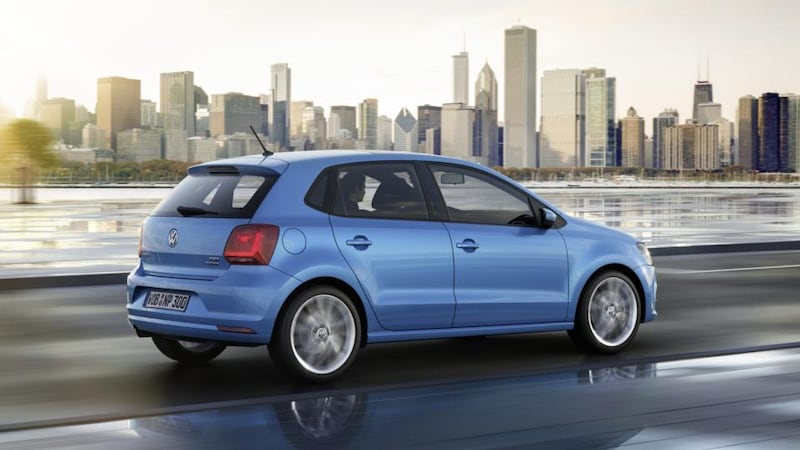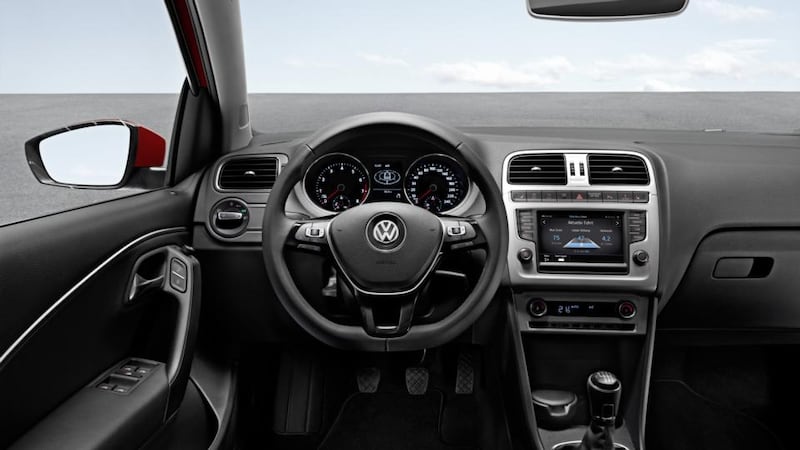You’re going to have to squint a bit. Well, you’re going to have to squint a bit if you want to spot the difference between this new, updated VW Polo and its immediate predecessor. The exterior changes would challenge Le Corbusier for the minimalism trophy, even though the front end is actually virtually all new. It looks a bit more roundy, slightly less angular than before, almost as if VW is trying to inject some of the current Beetle’s character into the car that is actually the true Beetle successor.
Inside, the changes are a little more obvious. Chief amongst them is the new touch-screen controller in the centre of the dash, making the Polo only the second VW-badged car to receive this new technology, after the Golf. You can have it in either 5in or 6.5in and it functions exactly as does the one in the Golf, which is to say very nicely indeed. We especially like the way it can detect your finger hovering near the screen and makes the buttons bigger and easier to hit. The steering wheel is also new, its skeletal construction also more or less lifted from the Golf, while the main instruments are also new, although they really do look much as before.
Underneath, there are more significant changes. All new Polos will get a new post-crash braking system. That sounds rather like an electronic post-horse-leaving-gate-bolting but actually it applies the brakes after a crash to prevent your car being shunted into a worse accident if hit by another when it’s stationary.


Higher-end safety systems such as a driver-drowsiness monitor, active cruise control and an autonomous city braking system are available on the options list. Also available will be a system called MirrorLink, which will allow you to connect your Android smartphone directly to the car, although Apple’s similar CarPlay system is not yet on the cards. Sports suspension will also now be available as an option, which should give buyers a tiny taste of what the forthcoming Polo GTI will be like to drive.
Engine changes
Of rather more significance is a series of engine changes. The old Polo's rather wheezy 1.2-litre petrol engines are being replaced by a new 1.0-litre three-cylinder unit, with either 60hp or 75hp. They're closely related to the engine found in the dinky little Up city car, but surely if the old 1.2s struggled with even basic rice-pudding-skin-pulling, an even smaller engine will be even worse?
Apparently not. Our test car was a pretty basic Trendline model with a pretty basic 60hp engine. It should have felt slow and breathless, just like its 1.2 predecessor. But it didn’t – in fact, it felt quite lively, belying its 0-100km/h in 15.5seconds time. OK, so you’re not going to be sidling up beside 911 Turbos, but for a small engine in a one-tonne car, it’s not bad and pulls very decently until you get the gearbox into a high-striding fifth, after which performance does tend to tail off a little.
It’s very good when it comes to CO2 emissions and claimed economy. 106g/km is a figure that diesel engines once struggled to meet, and yet here is a free-revving, raspy little petrol doing its best DERV impression. Low motor tax is nice, but you’ll probably struggle to match the 5.0-litres per 100km claimed fuel consumption figure (around 55mpg). Our test wasn’t long enough to do a thorough fuel evaluation but I reckon you’ll most likely get closer to 6.0l/100km. Still not bad.
It’s in the driving that the Polo really makes its mark, though. While the understated styling and high-quality cabin have obvious appeal, it’s the way the Polo gets down the road that really endears it to us. No, it’s not as communicative as Ford’s much more enthusiastic Fiesta. It’s actually a much more relaxing drive than the Ford, with a quieter engine than Ford’s 1.0-litre EcoBoost and softer suspension. That can occasionally make the Polo feel a bit over-sprung on really bad roads, but for the rest of the time it just feels comfy, flexible and pleasant. Is the steering a bit too light for accuracy? Yes, a bit, and the gearshift doesn’t like to be rushed either, but if you plug yourself into the Polo’s style, it’s a surprisingly satisfying car to drive.
I’ve mentioned that it’s not as much fun as a Fiesta, and also loses out in the space race to the likes of the Toyota Yaris and Honda Jazz, both of which have much more rear-seat space. The Polo’s 280-litre boot is also at the lower end of the class average and might be a touch too tight for a growing family dealing with buggies and bags every day.
Lacks nth degree
There's also the slight but noticeable sensation that the Polo just doesn't feel quite as well engineered as a Golf. For its class, the Polo is fine excellent even, but the Golf feels like it can compete with even big premium brand cars in terms of quality, and the Polo just lacks that nth degree of quality sensation. Given VW's stellar showing in the JD Power customer satisfaction rankings this year, though, that's unlikely to be a serious long-term concern.
So while the Polo does still feel a touch dour and, shall we say, "vanilla" next to the more characterful look and feel of a Fiesta or a Peugeot 208, it still sends out all the right vibes of sense and sensibleness. Even squinting hard, I don't think you'll see that as representing any change at all.
The lowdown: VW Polo 1.0 60hp Trendline
Price: €15,595 as tested. Polo pricing starts at €14,995
Power: 60hp
Torque: 95Nm
0-100kmh: 15.5sec
Top speed: 161kmh
Claimed economy: 5.0l/100km (65mpg)
CO2 emissions: 106g/km
Motor tax: €190
Our verdict: Lacks a little in excitement, but sensible, solid and satisfying











